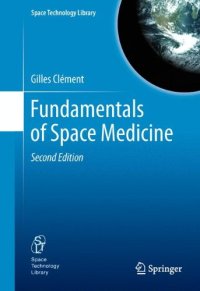
Ebook: Fundamentals of Space Medicine
Author: Gilles Clément (auth.)
- Genre: Medicine
- Tags: Astronomy Astrophysics and Cosmology, Aerospace Technology and Astronautics, Life Sciences general, Medicine/Public Health general, Social Sciences general
- Series: Space Technology Library 23
- Year: 2011
- Publisher: Springer-Verlag New York
- Edition: 2
- Language: English
- pdf
About 1200 human space flights have been completed to date, including more than 500 astronauts from various countries, for a combined total presence in space of about 90 years. The 21st expedition crew is currently in residence aboard the International Space Station, continuing a permanent presence in space that began in 2000. During that time, investigations have been conducted on both humans and animal models to study bone demineralization, muscle de-conditioning, space motion sickness, changes in immune function, crew and crew-ground interactions, post flight orthostatic intolerance, and the medical issues of living in a space environment, such as the effects of radiation and the risk of developing kidney stones. Results of these investigations have led to fundamental discoveries about the adaptation of the human body to the space environment. Gilles Clément has been active in this research. This book presents in a readable text the findings from life science experiments conducted during and after space missions.
"Fundamentals of Space Medicine, 2nd Edition" looks at the future of human space flight and what comes next. For the next ten years, the ISS will be a fully operational material and life science laboratory with a permanent crew of six astronauts. A new spacecraft named Orion will soon replace the Space Shuttle for transporting humans to the ISS and later to the Moon and Mars. However, many physiological, psychological, operational, and scientific issues need to be solved before establishing manned Moon and Mars bases. Finally, the emerging commercial sub-orbital flight capability captures the imagination of both the public and the scientific community. This book also identifies the showstoppers that are foreseen for all these space missions, and what do we need to learn to understand fully the implications and risks for space explorers and space tourists.
Investigations in space have led to fundamental discoveries of the human body to the space environment. Gilles Cl?ment has conducted extensive research in this field. This readable text presents the findings from the life science experiments conducted during and after space missions. About 1200 human space flights have been completed to date, including more than 500 astronauts from various countries, for a combined total presence in space of about 90 years. The first edition of this title was published in 2005 (written in 2003 – 2004), and new data is now available from crewmembers participating in long-duration flights on board the International Space Station (ISS). The number of astronauts who have spent six months in orbit has doubled since 2004. On board the ISS, the astronauts use newly developed pharmaceutical countermeasure for bone loss (such as biophosphonates) and state-of-the-art exercise resistive devices against muscle atrophy and cardiovascular deterioration. The ISS life support systems now use advanced closed-loop systems for meeting the needs of a 6-person crew, including recycling urine to water. Some of these new technologies have potential spin-offs for medical (i.e., sedentary life style, obesity) and environmental issues here on Earth. And finally, there are new space research opportunities with the Orion space vehicle that will soon replace the Space Shuttle, the Moon, and Mars space exploration program that is slowly but surely taking shape, and the space tourism sector that has become a reality. The focus on this edition is the ISS, Orion and planetary exploration, and space tourism. This edition also includes more than 20% new material, along with photographs, data, and video clips for Springer Extras!